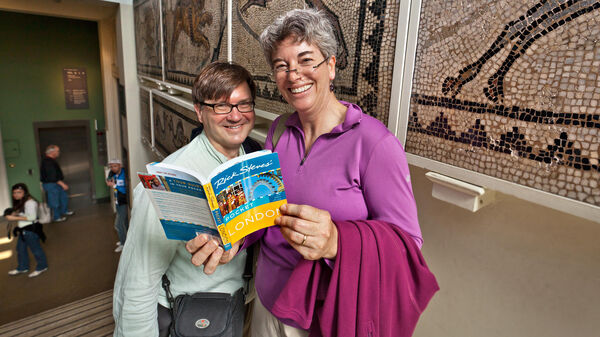Comparing Guidebook Series
By Rick Steves
I am amazed by the many otherwise smart people who base the trip of a lifetime on a borrowed copy of a three-year-old guidebook. The money they save in the bookstore is wasted the first day of their trip, searching for buses that no longer run and restaurants that have long since closed. Guidebooks are $25 tools for $4,000 experiences. As a writer — and user — of guidebooks, I am a big believer in their worth. When I visit somewhere as a rank beginner, I equip myself with a good, up-to-date guidebook. With this tool I can travel like an old pro, not because I'm a super traveler, but because I have reliable information and I use it.
With a good guidebook, you can come into Paris for your first time, go anywhere in town for less than $2 on the subway, enjoy a memorable bistro lunch for $25, and pay $150 for a double room in a friendly hotel on a pedestrian-only street a few blocks from the Eiffel Tower — so French that when you step outside in the morning, you feel you must have been a poodle in a previous life.
Before buying any guidebook, check the publication date. If it's last year's edition, find out when the new version is due out. Most guidebooks get an update every three or four years. Only a handful of titles (including my most popular books) are actually updated in person with regularity. When I'm choosing between guidebooks for a certain destination, the publication date (often on the copyright page) is usually the deciding factor.
Guidebook Series
Every guidebook series has an area of specialization: Some are great for hotels, but fall down on restaurants. Other series can't be beat for history and culture. Some guidebooks (like mine) are more opinionated and selective, choosing only the most worthwhile destinations in each country and covering them in depth. Others seek to cover every possible destination you might find yourself in.
Rick Steves: My series, written and refined over the last three decades, is designed to help smooth your travels and broaden your cultural experiences. With the help of my research partners, I update my guidebooks lovingly and in person. In order to experience the same Europe that most of my readers do, I insist on doing my research in the peak tourist season — from April through September. And I'm stubbornly selective, writing about fewer destinations than other guidebooks. For example, Italy has dozens of hill towns, but my Italy book zooms in on the handful that are truly worth the trip. I base my depth of coverage on a place's worthiness, rather than its population or fame.
When I travel in Europe and beyond — to areas I don't cover in my books — I routinely use guidebooks from these publishers, and find them helpful.
Lonely Planet: The worldwide standard for a solid guidebook, Lonely Planet covers most countries in Europe, Asia, Africa, and the Americas. The Lonely Planet series offers comprehensive, no-nonsense facts, low- and mid-budget listings, and helpful on-the-ground travel tips.
Frommer's Guides: The granddaddy of travel publishing, Arthur Frommer has reinvented his series to be leaner and more focused on the budget traveler. These books are especially well attuned to the needs of older travelers, but some readers may feel like they're being handled with unnecessary kid gloves.
Fodor's Travel: A stalwart of travel publishing, Fodor's has been producing good basic European guidebooks for American travelers since the 1930s. Their coverage is more encyclopedic than inspiring.
DK Eyewitness Travel: These gorgeous visual guides offer appealing color photos and illustrations (like cutaway cross-sections of important castles and churches). They are great for trip planning and visual learners, but the written information is scant — I don't travel with them.
Rough Guides: This British series is written by Europeans who understand the contemporary social scene better than most American writers. While their hotel listings can be skimpy and uninspired, the historical and sightseeing information tends to offer greater depth than others.
Michelin Green Guides: From a French publisher, these tall, green books are packed with color maps and photos, plus small but encyclopedic chapters on history, lifestyles, art, culture, and customs. Recent editions also list hotels and restaurants. The Michelin Red Guides are the hotel and restaurant connoisseur's bibles.
Bradt Travel Guides: This British series, specializing in off-the-beaten-track destinations throughout Europe (and the world), offers plenty of cultural insights in addition to solid nitty-gritty details.
Blue Guides: Known for a dry and scholarly approach, these guides are ideal if you want a deep dive into history, art, architecture, and culture. With the Blue Guide to Greece, I had all the information I needed about every sight and never needed to hire a guide. Scholarly types actually find a faint but endearing personality hiding between the sheets of their Blue Guides.
Ebooks or Hard Copy?
Many guidebook series, including most of my titles, are available as ebooks. While I still consider myself a paper guy, there are advantages to going digital. You can carry multiple ebooks without adding weight to your bag (great for long, multidestination trips), and you can buy books on the go (convenient for spur-of-the-moment detours). Someday ebooks may offer more benefits than traditional paper books, but for now they have limitations. It can be difficult to find the information you're looking for; flipping from page to page is awkward; and maps — often designed to run across two pages — don't always appear correctly. Until the perfect digital solution arrives, I believe a printed guidebook remains the most practical format.


